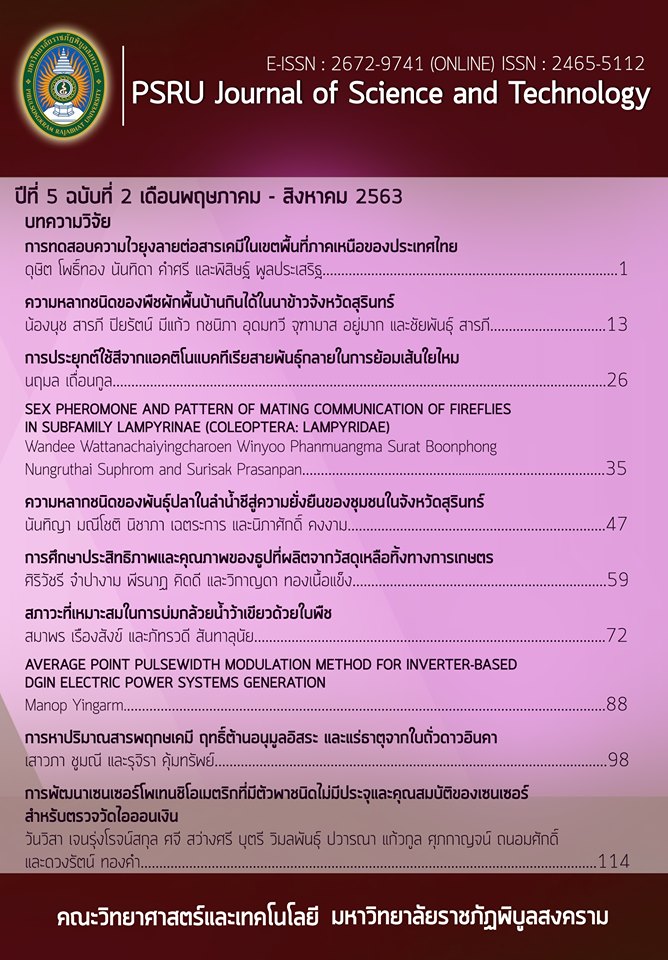THE STUDY OF THE EFFICIENCY AND QUALITY OF INCENSE PRODUCTION FROM AGRICULTURAL WASTES
Keywords:
Incense, Agricultural waste, Oil palm frond, Bagasse, Rice huskAbstract
The objectives of this research were investigated the efficiency and quality of incense from agricultural wastes including oil palm frond, bagasse and rice husk and studied on the concentration of lead in incense ash from agricultural wastes. The efficiency of incense was examined time combustion, weight, total suspended particle and smoke whereas the quality of incenses was inspected surface, colour and texture. The efficiency and quality of the incense and lead concentration of the incense ash were compared to commercial incense which qualified by Thai industrial standards (TIS). The results found that oil palm frond was an agricultural waste which used to produce superiority incense. The incense product from oil palm frond was the shortest combustion time at 29.86±6.031 minute. The average of total suspended particle of the incense product from oil palm frond was 0.551×10-4±0.107×10-4 mg/m3. The smoke was low and the surface was slightly rough. The lead concentration of the incense ash from oil palm frond was 2.548±0.021 mg/kg under quality standard. The comparison of the efficiency, quality of the incense product and the lead concentration of the incense ash from oil palm with the commercial incense product was nearly equivalent standards. However, the production of incense from agricultural waste was slightly rough surface and loose texture. Therefore, the production of incense from agricultural waste for business competition should be improved the surface and texture of incense.
References
กรมพัฒนาพลังงานทดแทนและอนุรักษ์พลังงาน. (2561). ชีวมวล. กรุงเทพฯ: กรมพัฒนาพลังงานทดแทนและอนุรักษ์พลังงาน กระทรวงพลังงาน.
กองประเมินผลกระทบต่อสุขภาพ. (2558). ผลกระทบต่อสุขภาพจากควันธูปขี้เถ้าธูป ไอระเหยและขี้เถ้าจากการเผากระดาษเงินกระดาษทองในช่วงเทศกาลตรุษจีน. กรุงเทพฯ: กรมอนามัย กระทรวงสาธารณสุข.
นักรบ เจริญสุข, รัศมี แสงศิริมงคลยิ่ง, ดุษณี ศุภวรรธนะกุล, และวิไลลักษณ์ สุวจิตตานนท์. (2558). การพัฒนาส่วนผสมของธูปเพื่อลดสารก่อมะเร็งในควันธูป. วารสารวิจัยและพัฒนา วไลยอลงกรณ์ในพระบรมราชูปถัมภ์, 10(3), 75-84.
ประกาศกระทรวงสาธารณสุข ฉบับที่ 98 (พ.ศ. 2529) เรื่อง มาตรฐานอาหารที่มีสารปนเปื้อน. (2529, 16 กุมภาพันธ์). ราชกิจจานุเบกษา. เล่มที่ 103 ตอนที่ 23.
ประกาศกระทรวงอุตสาหกรรม ฉบับที่ 3767 (พ.ศ. 2550) ออกตามความในพระราชบัญญัติมาตรฐานผลิตภัณฑ์อุตสาหกรรม พ.ศ. 2511
เรื่อง กำหนดมาตรฐานผลิตภัณฑ์อุตสาหกรรมธูป. (2550, 19 พฤศจิกายน). ราชกิจจานุเบกษา. เล่มที่ 124 ตอนพิเศษ 179 ง.
ประกาศคณะกรรมการสิ่งแวดล้อมแห่งชาติ ฉบับที่ 10 (พ.ศ. 2538) ออกตามความในพระราชบัญญัติส่งเสริมและรักษาคุณภาพสิ่งแวดล้อมแห่งชาติ พ.ศ. 2535 เรื่อง กำหนดมาตรฐานคุณภาพอากาศในบรรยากาศโดยทั่วไป. (2538, 5 กันยายน). ราชกิจจานุเบกษา. เล่มที่ 112 ตอนที่ 43 ง.
ประกาศสำนักงานมาตรฐานผลิตภัณฑ์อุตสาหกรรม ฉบับที่ 1586 (พ.ศ. 2553) เรื่อง ยกเลิกและกำหนดมาตรฐานผลิตภัณฑ์ชุมชนธูปหอม. (2553, 28 กันยายน). สำนักงานมาตรฐานผลิตภัณฑ์อุตสาหกรรม. มผช. 181/2553.
มยุรี อุรารุ่งโรจน์, ประกาย บริบูรณ์, และพนาวัลย์ กลึงกลางดอน. (2548). การศึกษาปริมาณโลหะเป็นพิษในอาหารที่คนไทยบริโภคต่อวัน ระหว่าง พ.ศ. 2542-2544. วารสารกรมวิทยาศาสตร์การแพทย์, 47(4), 234-247.
ศูนย์เชื้อเพลิงและพลังงานจากชีวมวล. (2559). ศักยภาพชีวมวลในประเทศไทย. กรุงเทพฯ: คณะวิทยาศาสตร์ จุฬาลงกรณ์มหาวิทยาลัย.
ศูนย์อนามัยที่ 8 อุดรธานี. (2562). ควันธูป. อุดรธานี: กรมอนามัย กระทรวงสาธารณสุข.
สำนักงานคณะกรรมการอ้อยและน้ำตาลทราย. (2560). การใช้ประโยชน์จากอ้อยและผลิตภัณฑ์จากอ้อย. กรุงเทพฯ: สำนักงานคณะกรรมการอ้อยและน้ำตาลทราย กระทรวงอุตสาหกรรม.
อุษณีย์ บุษเนียร. (2559). รูปแบบและกลยุทธ์ทางการตลาดของผู้ประกอบการธุรกิจผลิตธูปในพื้นที่จังหวัดนครปฐม. (วิทยานิพนธ์ปริญญามหาบัณฑิต). มหาวิทยาลัยศิลปากร, บัณฑิตวิทยาลัย, สาขาวิชาการจัดการภาครัฐและภาคเอกชน.
Elsayed, Y., Dalibalta, S., Gomes, I., Fernandes, N. & Alqtaishat, F. (2016). Chemical composition and potential health risks of raw Arabian incense (Bakhour). Journal of Saudi Chemical Society, 20(4), 465-473.
JECFA. (1994). Summary of evaluations performed by the joint FAO/WHO expert committee on food additives (JECFA) 1946-1993 1st-45th meetings. USA.: Washington, D.C.
Zhang, J., Chen, W., Li, J., Yu, S. & Zhao, W. (2015). VOCs and Particulate Pollution due to Incense Burning in Temples, China. Procedia Engineering, 121, 992–1000.
Downloads
Published
How to Cite
Issue
Section
License
กองบรรณาธิการขอสงวนสิทธิ์ในการปรับปรุงแก้ไขตัวอักษรและคำสะกดต่างๆ ที่ไม่ถูกต้อง และต้นฉบับที่ได้รับการตีพิมพ์ในวารสาร PSRU Journal of Science and Technology ถือเป็นกรรมสิทธิ์ของคณะวิทยาศาสตร์และเทคโนโลยี มหาวิทยาลัยราชภัฏพิบูลสงคราม และ
ผลการพิจารณาคัดเลือกบทความตีพิมพ์ในวารสารให้ถือมติของกองบรรณาธิการเป็นที่สิ้นสุด







